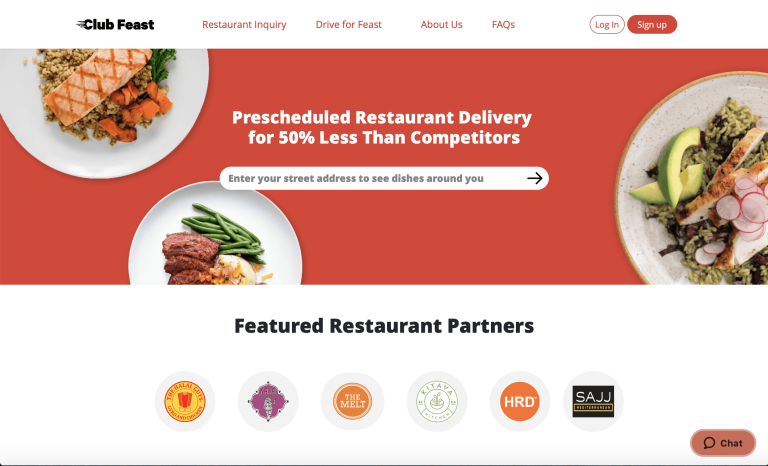But the challenges built into the business model are becoming clearer by the day. Restaurants struggle to afford the third-party fees, while the delivery services have to fight to survive against restrictions placed on those same fees. All the while, consumers must contend with the upcharges that restaurants and third-party services add to ameliorate these crippling costs. Now, one startup sees a solution: create a delivery subscription where every meal costs no more than $9.
Too good to be true? Far from a castle in the air, this is the idea behind a multimillion-dollar startup founded by a highly accomplished trio of creators: a co-founder of Seated, a former director at Goldman Sachs, and a former principal at Roivant. The company, Club Feast, a subscription-based restaurant delivery service, came out of a seed funding round in January with $3.5 million. The company is using the money to develop its products, grow its team and expand to more cities throughout the year.
In a conversation with Karen Webster, Atallah Atallah, Club Feast’s CEO and co-founder (the one who co-founded Seated), said of the food delivery process, “When you talk to a restaurant owner, to even the driver, to even the company itself, no one is happy. Everyone is like, ‘We’re not making money.’ Where’s the money going? So, when we really dig into the whole process, we realize that you need to restructure every single part of the equation.”
Improving The Process For Consumers, Restaurants And Drivers
As Paytronix Co-founder and CEO Andrew Robbins told PYMNTS in November, the trick with a subscription service isn’t just in building it out, but building it right. An offering has to scratch an itch the consumer was feeling, but still be a revenue driver for the merchant. For instance, he said that if Starbucks started offering all-you-can-drink coffee for $9 a month, it would fail quickly because the chain’s core heavy users come very frequently just to buy coffee. But a convenience store with the same offering might make money on attachment sales from gasoline, pastry items and breakfast sandwiches.
Advertisement: Scroll to Continue
To build its subscription service right, Club Feast focuses on offering low prices on the consumer side and efficiency and transparency on the restaurant and driver sides. According to the subscription service’s site, its meals cost “50 percent less than competitors.” Consumers purchase meal credits in advance according to how many meals they expect to order each week. They place their orders using these credits by 6 p.m. the day before delivery, giving restaurants and drivers plenty of advance notice. Meal credits cost $5.99 plus taxes and a delivery fee, totaling $8.50-$9 per meal.
For restaurant owners, Atallah explained, Club Feast offers “a very friendly version of delivery” that cuts out the intimidating last-minute rush of traditional delivery models. Kitchens also know in advance how many Club Feast meals they will be preparing the next day, giving them the opportunity to prepare as necessary. The company also cuts out time- and labor-intensive sticking points like customization and overabundance of menu offerings — the platform only offers four or five set meals per restaurant.
Like restaurant owners, Club Feast’s drivers also receive information in advance about how many orders they will have to fulfill the next day, as well as information about what their hours will be and where they’re going.
“We want zero loss,” said Atallah, clarifying that this goal extends to all parties involved in the transaction.
One Size Does Not Fit All
Rather than entirely replacing popular third-party delivery services, Club Feast sees itself as a solution to a different problem.
“We don’t compete with DoorDash, Uber Eats,” said Atallah. Instead, the subscriptions service is “a hybrid between restaurant delivery [and] meal prep.” It is a more affordable option for the everyday meals for which consumers do not need to be spending premium prices.
Given that consumers eat about 21 meals per week, Club Feast aims to offer an affordable solution for the meals that are not necessarily special occasions. Other meal delivery services, Atallah explained, are more able to serve consumers’ moment-to-moment choice.
“In Uber Eats, you’re not going to care about the extra $5 or extra $10,” he said. “You’re hungry. It’s 10 p.m. on a Saturday. Even if you have to pay a hundred dollars, you’re going to buy it.”
Club Feast, however, offers a pre-planned solution for routine meals.
Prioritizing Subscriber Satisfaction
Despite the subscription service’s somewhat workaday goals, the meals themselves are meant to be highly satisfying to consumers.
“As long as the subscriber is happy,” summarized Atallah.
To that end, Club Feast removes meals that do not receive high ratings from the platform and focuses on featuring high-quality offerings made with good ingredients.
“Like I always tell the team: Even if you offer the food for free, if it’s a bad meal, the subscribers will quit,” Atallah said.
As an extension of this subscriber-centric approach, the company makes up for the pared down menus it offers at each restaurant with the volume of total restaurants available on the platform. Before its upcoming launch in New York City, and its expansion to other cities later in the year, Club Feast is focusing on offering as many high-quality choices as possible.
Ultimately, however quickly the company is growing, Atallah said, Club Feast “genuinely want[s] to make sure that the three sides are benefiting,” never expanding faster than the service itself can support. “And that’s, for us, the core of our growth.”

